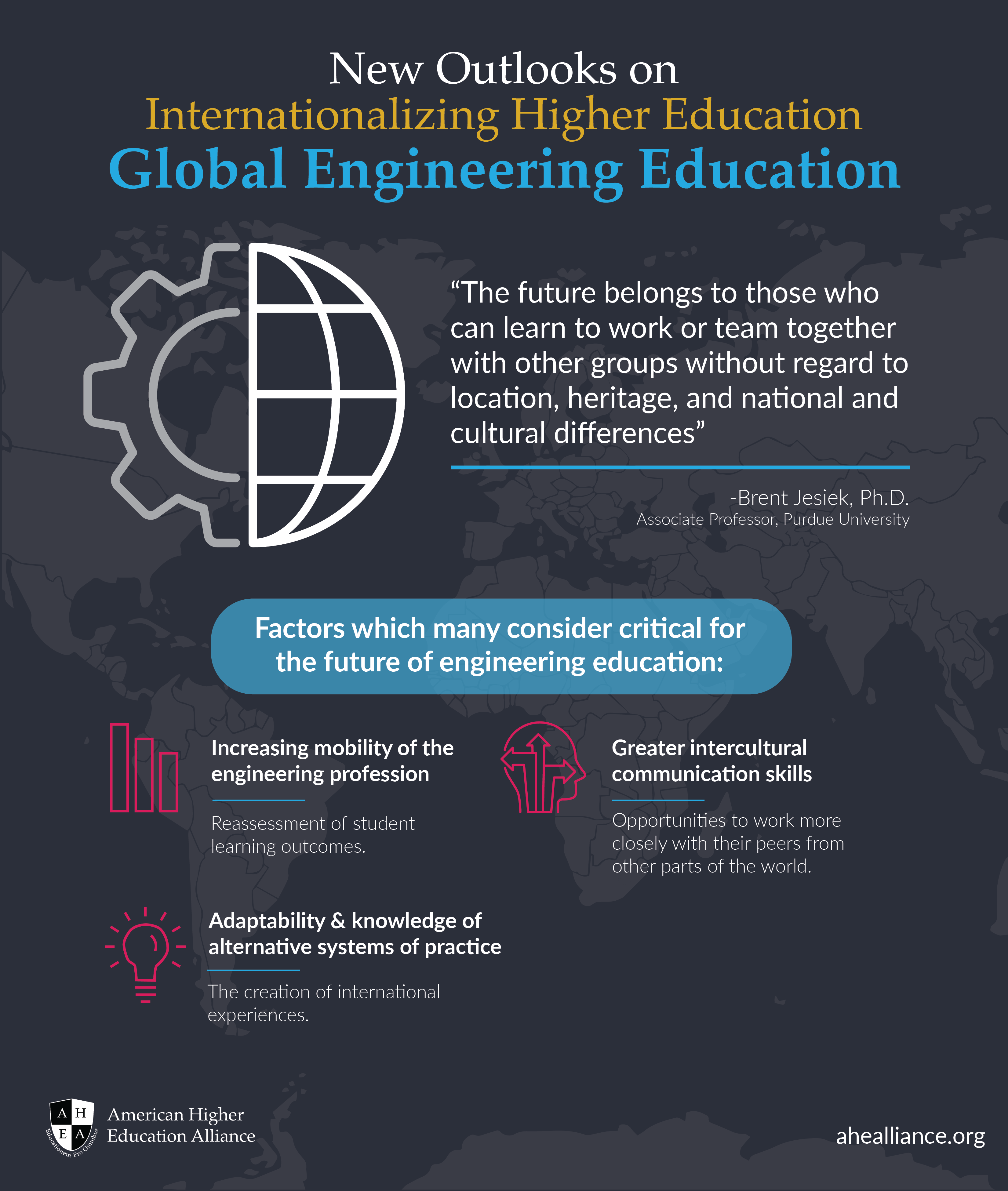
New Outlooks on Internationalizing Higher Education Global Engineering Education

Previous AHEA research reviews have highlighted the efforts being made to internationalize selected fields of study such as business. The present article revisits this subject and describes internationalization developments in the area of engineering education. In doing so, it identifies some of the trends which scholars believe call for further steps in this direction. The literature reviewed here also gives attention to the creation of learning outcomes and the kinds of international educational experiences deemed critical to the success of such initiatives.
The arguments for internationalizing engineering education are persuasive and often related to the issue of mobility. As John Grandin and Norbert Hedderich write in ‘Global Competence for Engineers,’ ‘technological superiority is […] no longer geographically privileged. Talent may now be sought everywhere, bringing people together on teams’ (Grandin and Hedderich, 362). The authors go on to note that if many successful examples of collaboration can be cited, ‘one can well imagine the potential for misunderstandings when engineering teams [composed of people] from so many cultural perspectives decide to collaborate’ (Ibid, 363).
If therefore ‘the future belongs to those who can learn to work or team together with other groups without regard to location, heritage, and national and cultural differences,’ the merits of providing students with the intercultural and communication skills required to be effective in such circumstances could not be any clearer (ibid). Brent Jesiek and his co-authors make similar points when writing of the need for fashioning learning outcomes which specify goals such as the ability to ‘adapt to cultural norms in the professional arena and act appropriately,’ ‘communicate professionally in a culturally appropriate manner,’ and ‘contribute to a culturally diverse team,’ as (Jesiek, Zhu et al, 7; see also Downey et al. 3). The importance and increasing attention given to the development of such skills is in fact reflected in the student learning outcomes adopted by the Accreditation Board for Engineering and Technology.
In addition to elevating the importance of intercultural communication skills, mobility also exposes engineers to different forms of practice. ‘The increased mobility of engineers,’ write for example the authors of another recent study, ‘poses new and difficult challenges to country-based systems of engineering education and training, whose advocates now face the fearful possibility that their graduates may not possess competencies recognized as valuable in other countries or by international employers operating within their own country’ (Lucena et al, 433). Whether working therefore ‘on multi-national project teams, navigating geographically dispersed supply chains, or engaging customers and clients abroad, engineering graduates encounter worlds of professional practice that are increasingly global in character’ (Jesiek, Zhu et al, 1).
When speaking of ‘worlds of professional practice,’ Jesiek and his co-authors refer to the existence of diverse ‘engineering cultures’ and the corresponding need to prepare students to successfully interact with colleagues trained under different systems (Jesiek, Haller et al, 9). In ‘The Globally Competent Engineer,’ Gary Downey and his co-authors write for example that ‘exercises in global learning that place students into contact with engineers or engineering students in other countries contribute directly to this important movement to demonstrate that engineering problems can be solved in more than one way.’ They note furthermore the results of one study in which French and American students in a civil engineering class learned this point first-hand -- the former solving their homework problems ‘by deriving the answer mathematically from first principles,’ and the latter by ‘using graphical methods’ (Downey et al, 3)
Downey and his colleagues add that ‘the key achievement in the often-stated goal of working effectively with different cultures is learning to work effectively with people who define problems differently than oneself’ (Downey et al, 1). The skills required of a ‘globally competent engineer’ should thus include items such as a ‘positive attitude to ideas, issues, and people outside of one’s realm,’ ‘willingness to tolerate ambiguity,’ and the ‘ability to work with people who define problems differently and use different engineering and managerial approaches to solve them’ (Grandin and Hedderich, 368; see also Jesiek, Zhu et al, 7; Jesiek, Haller et al, 9). That said, the scholars cited above would tend to agree with the view of Downey and his co-authors that ‘in the United States, the traditional engineering method, which is still taught regularly in engineering science courses, offers no method or mechanism for working with people who draw boundaries around problems in different manners’ (Downey et al. 3).
In addition to treating these shortcomings through the creation and adoption of new learning outcomes, the works discussed here offer insights too on the types of international experiences deemed most conducive to their acquisition. Emphasis is often placed on experiential learning opportunities, or ‘hands-on and/or project-based work situated in global context,’ that go beyond conventional study abroad formats. For Downey and his co-authors, programs of this kind contain many features that should appeal to professional school students, such as ‘better scheduling flexibility, work positions that may include some sort of salary, research options for graduate students, and less problems with determining course-to-course equivalencies for credit transfer’ (Downey et al, 3). Grandin and Hedderich similarly express a preference for longer versus shorter international experiences and the creation of ‘supervised professional internships’ (Grandin and Hedderich, 370).
As other researchers point out, there are nevertheless considerable challenges to be met in putting such programs into place. Jesiek and his co-authors cite for example the importance of ample predeparture training, a point made often in previous articles in this series, as well as ‘identifying sources of funding, sustaining cross-national relationships, and systematically evaluating learning outcomes and other kinds of impacts’ (Jesiek, Haller et al, 3). Still other researchers call for greater employment of transnational course options – another subject dealt with previously in AHEA research reviews (Moore et al). In the case finally of assessment, the authors cited throughout place emphasis on ‘mixed-method’ approaches which ‘leverage multiple direct and indirect measures’ (Jesiek, Haller et al, 24). The instruments used in such endeavors may include for example a combination of ‘self-assessment questions […] open-ended scenario prompts […] and re-entry interviews’ (Jesiek, Haller et al, 24).
In conclusion, the preceding literature review has indicated the factors which many consider critical for the future of engineering education. Stress is placed on the increasing mobility of the engineering profession and the consequent need for greater intercultural communication skills, adaptability, and knowledge of alternative systems of practice. As indicated above, the options for addressing these concerns range from a reassessment of student learning outcomes and the creation of international experiences that provide students with new opportunities to work more closely with their peers from other parts of the world.
Works Cited
Downey, Gary Lee, Juan C. Lucena, Barbara M. Moskal, Rosamond Parkhurst, Thomas Bigley, Chris Hays, Brent K. Jesiek et al. ‘The Globally Competent Engineer: Working Effectively with People Who Define Problems Differently’, Journal of Engineering Education 95, 2 (2006), pp. 1-17.
Grandin, John M., and Norbert Hedderich. ‘Global Competence for Engineers’, in The SAGE Handbook of Intercultural Competence (London: Sage, 2009), pp. 362-373.
Heckel, Ute, Ursula Bach, Anja Richert, Sabina Jeschke, and Marcus Petermann. ‘International Student Mobility in Engineering Education’, in Engineering Education 4.0 (Springer: Cham, 2016), pp. 561-573.
Jesiek, Brent K., Yating Haller, and Julia Thompson. ‘Developing Globally Competent Engineering Researchers: Outcomes-Based Instructional and Assessment Strategies from the IREE 2010 China Research Abroad Program’, Advances in Engineering Education 4, 1 (2014), pp. 1-31.
Jesiek, Brent K., Qin Zhu, Sang Eun Woo, Julia Thompson, and Andrea Mazzurco. ‘Global Engineering Competency in Context: Situations and Behaviors’, Online Journal for Global Engineering Education 8, 1 (2014), pp. 1-16.
Lucena, Juan, Gary Downey, Brent Jesiek, and Sharon Elber. ‘Competencies Beyond Countries: The Re‐organization of Engineering Education in the United States, Europe, and Latin America’, Journal of Engineering Education 97, 4 (2008), pp. 433-447.
May, Dominik, and Erman Tekkaya. ‘The Globally Competent Engineer–What Different Stakeholders Say About Educating Engineers for a Globalized World’, in Engineering Education 4.0 (Springer: Cham, 2016), pp. 895-910.
Moore, Stephanie, Dominik May, and Kari Wold. ‘Developing Cultural Competency in Engineering Through Transnational Distance Learning’, in Engineering Education 4.0 (Springer: Cham, 2016), pp. 777-798.
